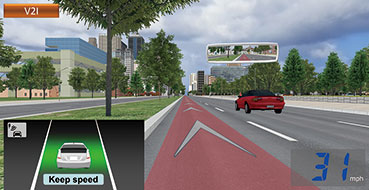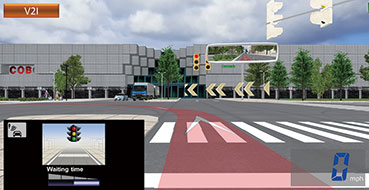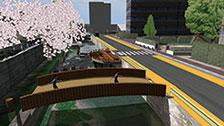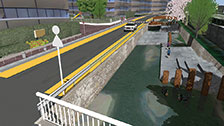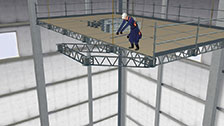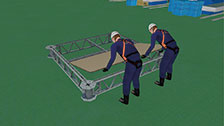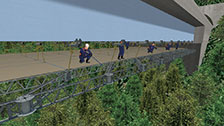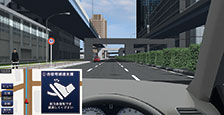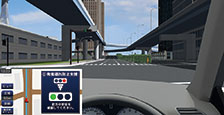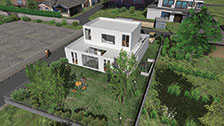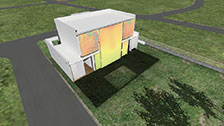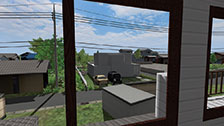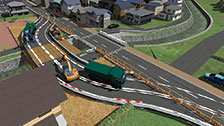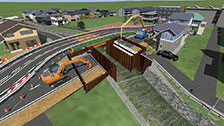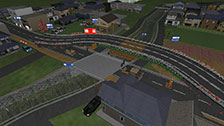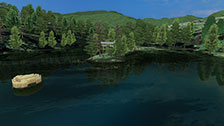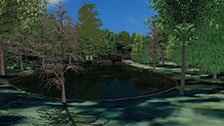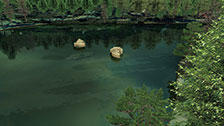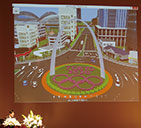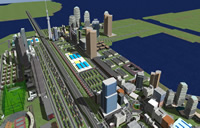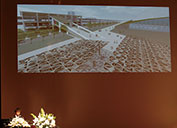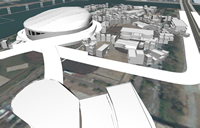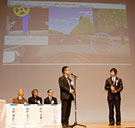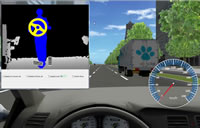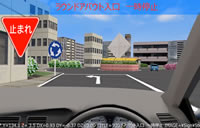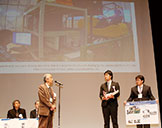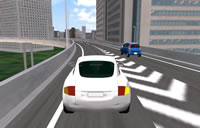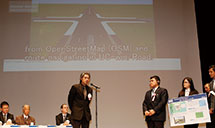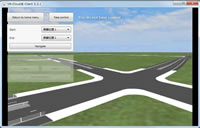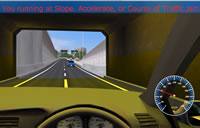Date: November 19-21, 2014
Venue: Shinagawa Intercity Hall / FORUM8 Tokyo head office |
(Up&Coming New Year Issue) |
A Variety of Solutions Supporting CIM Gathered Together.
Contests to Compete Original Technologies Expanded
We FORUM8 held "FORUM8 Design Festival 2014-3Days" for three days from November 19 to 21, 2014, at our Tokyo head office (Shinagawa Intercity A-21F) and Shinagawa Intercity Hall.
Originally multiple events had been held separately until 2009, when they
were reorganized into "Design Festival". Since then the Festival
is held every year for three days in fall with these events put altogether.
Being the 6th this year, the Festival centered on three events of "the
15th UC-win/Road Conference (VR Conference)", "The 8th Design
Conference," and "the 7th International VR Symposium".
It also comprised open judgment and award ceremony of "the 13th 3DVR
Simulation Contest on Cloud", "the 4th Virtual Design World Cup
(VDWC)", "the 2nd Cloud Programming World Cup (CPWC)", and
"the 1st National Resilience Design Award", as well as exhibition
and information sessions, and training seminars etc. |
 |
| |
 Greetings from Yuji Ito, President of FORUM8 Greetings from Yuji Ito, President of FORUM8 |
Focus on Advanced Technologies about VR and Design
Day 1 of the Design Festival got started with exhibition and information session in the showroom of FORUM8 Tokyo head office in the morning. Exhibition of UC-win/Road Driving Simulator (DS), simulators for UC-win/Road, solutions, and diverse systems related to 3D VR engineering services were conducted along with demonstration.
Moving the venue to the Shinagawa Intercity Hall in the afternoon, <Driving Simulation Sessions> of the "15th UC-win/Road Conference" started.
In the morning of Day 2, <General Sessions> of the same "15th
UCwin/Road Conference" was held in the Shinagawa Intercity Hall. As
part of it, announcement of the prizewinners of "the 13th 3DVR Simulation
Contest on Cloud" and the award ceremony were held. Prior to this,
11 works had been nominated out of all the entries. They went through general
voting using VR-Cloud(R) over them. Then FORUM8 judging committee held
final judgment on November 18.
In the afternoon, different sessions that compose "the 8th Design Conference" were held in parallel at the same Hall and our Tokyo Office Seminar Room. <IM&VR Sessions> were held in the Hall, and <Geotechnical Sessions> in the Seminar Room. The former set of sessions started with open final judgment of "the 4th VDWC" (over 15 entries nominated previously out of all) and "the 2nd CPWC" (similarly over 6 nominated entries). Then several lectures were given, followed by the announcement of both WC and award ceremony to finish the sessions.
After the 2 sets of sessions were over, a networking party was held at Hall Foyer (in front of the Hall), which also announced the latest publication of 3 books by FORUM8 Publishing: Behavior-Security-Culture (BeSeCu)", "Recommendation for ICT Global Collaboration", and "Analysis for Flood Risk in an Urban Area".
In the Hall on Day3 (the last day of the Design Festival), <Design, Analysis and Seismic Sessions> of "the 8th Design Conference" were held throughout the morning and afternoon, with <CIM Sessions> at the last part. In the former sessions were held the announcement of prizewinners of "the 1st National Resilience Award" and its award ceremony. For this 10 entries were preliminarily nominated out of all, and our judgment committee held the final judgment on November 17.
In the Seminar Room, "the 7th International VR Symposium" was held in the morning, and <Water Works Sessions> of the Design Conference in the afternoon respectively.
During the Conference, in addition to the exhibition and information sessions
at the showroom and Hall Foyer as written above, Technical support / CIM
Experience Area was arranged in the presentation room in our Tokyo Head
Office. A large number of visitors experienced our latest products and
services.
Specific description of each event and session will follow.
 |
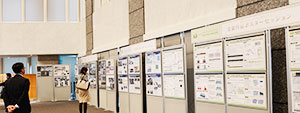 |
|
 Poster session of each award Poster session of each award |
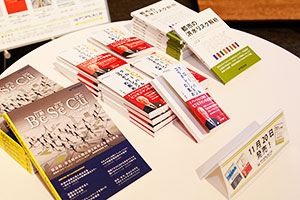 |
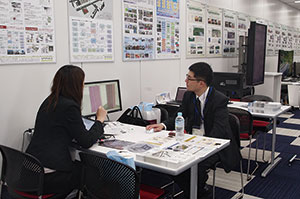 |
 Three new publications from FORUM8 Publishing Three new publications from FORUM8 Publishing |
 CIM Experience Area CIM Experience Area |

Advanced and Diversified Technical Discussion Developed Based on VR Technology
Day1 of the Design Festival (November 19, 2014) opened up in the morning at the showroom of FORUM8 Tokyo head office (Shinagawa Intercity A-21F) with exhibition and information session. Subsequently in the afternoon, <Driving Simulation Sessions> of "the 15th UC-win/Road Conference (VR Conference)" was held at Shinagawa Intercity Hall.
"UC-win/Road Conference" started in 2000, following the release of "UC-win/Road". |
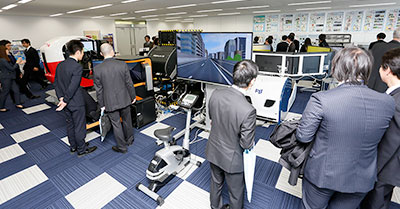 |
 |
 |
 |
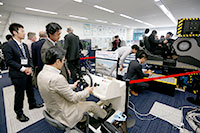 |
 Exhibition and information session in the showroom of Tokyo head office Exhibition and information session in the showroom of Tokyo head office |
Seeking for Advanced Reality, Application to Mobility Studies to Spread
Following the opening remarks (by FORUM8 President Yuji Ito), a special
lecture was given for <Driving Simulation Sessions> of "UCwin/Road
Conference" entitled "Development of the 8DOF large scale driving
simulator". Firstly Mr. Rongguy Zhou, Director of Road Safety Research
Center (RSRC), Ministry of Transport of China (MOT) mentioned the positioning
of RSRC and Research Institute of Highway (RIOH), and overview of the organizations
and scope of studies. Then he gave briefing of the experimental laboratory
where 8DOF large scale driving simulator (DS) was installed and the activities
there. He showed expectation towards collaboration with concerned Japanese
agencies.
 |
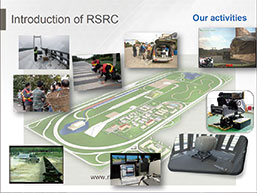 |
 Mr. Rongguy Zhou, Director of Road Safety Research Center (RSRC), Mr. Rongguy Zhou, Director of Road Safety Research Center (RSRC),
Ministry of Transport of China (MOT) |
In the latter part, Mr. Zhang Weihan, Research Fellow there expounded features of three types of DS and main application study cases, as well as the process of introducing DS dating back to 2007.
He summarized functions of the latest DS and scope of studies using DS
in RIOH etc. Then he mentioned a study on verification of the effect of
functions of DS itself or its motion platform etc., taking examples of
verifying visibility of road signs and driving simulation, along with studies
using the functions of DS to the fullest. As a few examples of this, he
explained the joint study with Canada focusing on the relationship between
human factors and traffic safety in various environments, and study on
safety measures towards Hong Kong-Zhuhai-Macau Bridge project. He stated
that they are also willing to put emphasis on studies using DS continuously.
 |
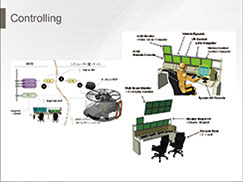 |
 Mr. Zhang Weihan, Research Fellow, RSRC, MOT Mr. Zhang Weihan, Research Fellow, RSRC, MOT |
The next special lecture ""Latest research towards the realization of green mobility society and the use of VR simulator" was given by Prof. Tetsunori Haraguchi, Specially Appointed Professor of Nagoya University. He gave an outline of his activities during his days in Toyota Motor Corporation and after he moved to Nagoya Univ., concepts and activities of "Nagoya COI (Center Of Innovation) Base" and "Social Innovation Design Study Center (SIDC)" established based on "COI Stream", a program of Ministry of Education, Culture, Sports, Science and Technology for creating innovation. Paying attention to possibilities of FORUM8 DS including the multi-driver function, he hit upon several ideas. Among them is a study on social acceptability of super-small personal mobility and the ride quality of the user, from a viewpoint of supplying mobility when the working generation shifts to the side of elderly generation. Another example is an application to the study on characteristics of vehicles by which tracking driving that tends to cause poor mileage can lead to improvement in practical mileage, from a viewpoint of controlling global warming. Then he explained the overview of DS he and others had introduced for the green mobility study, human engineering situations of using it so far, and problems found through them. He said that in NIC (National Innovation Complex), which is scheduled to be complete next spring, they plan to use DS of FORUM8 etc. to conduct studies on tracking driving, lane-change intervention assistance, drivers' behavior when reversing, and studies linking with simulators of traffic flow or vehicle motion. Finally, he drew future prediction of his own beyond the studies utilizing DS.
 |
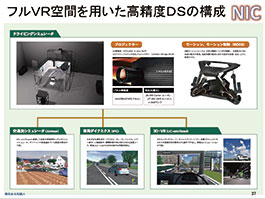 |
 Prof. Tetsunori Haraguchi, Specially Appointed Professor of Nagoya University Prof. Tetsunori Haraguchi, Specially Appointed Professor of Nagoya University |
After a break, greetings from an advisor was made by Mr. Hiroshi Komori,
former vice president of Central Motor Co.,Ltd. (currently TOYOTA MOTOR
EAST JAPAN, INC.), now Advisor of FORUM8 Co., Ltd.", entitled "Job-site
improvement and management reforms". At the beginning, he talked about
"Kaizen (improvement) Meister" established to contribute to Japanese
manufacturing companies through improvement at job sites practiced in Toyota
production system (TPS) with his colleagues (over 65 years old) after he
had retired from the former job. Based on his experience of involving with
business improvement in various small and medium-sized companies, he asserted
that the key to its success is human mind. After mentioning the concept
of TPS, he explained the following items with actual examples: "'on-site
and an actual good comes first' spirit" to know the site by oneself,
man build-up who thinks by oneself by doubting the current practice and
having no preoccupation, "also seeing the wood for the trees"
attitude, with which a manager have both viewpoints of on-site and business
strategy, and importance of consideration towards motivation. He developed
his lecture into challenges and countermeasures common to buildup of good
sites and business innovation, such as 4S (Seiri: arrangement, Seiton:
good order, Seiketsu: cleanliness, Seiso: cleaning), process improvement,
elimination of waste of stagnation by JIT (Just In Time), automation (separation
of human and machine), quality control (built-in quality with ownership
and time saving of PDCA), visualization (sharing information about problems).
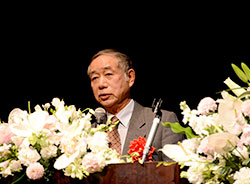 |
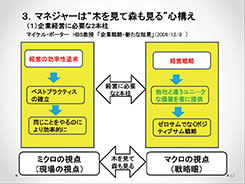 |
 Mr. Hiroshi Komori, Advisor of FORUM8 Co., Ltd / Kaizen Meister, Mr. Hiroshi Komori, Advisor of FORUM8 Co., Ltd / Kaizen Meister,
former vice president of Central Motor Co.,Ltd.
(currently TOYOTA MOTOR EAST JAPAN, INC.) |
Next presentation was "Latest function of UCwin/Road Ver.11 and its
future development", made by FORUM8 staff. As new functions of the
latest version of UC-win/Road (Ver.10.0 to be released in August) and the
next version under development (v11), he mentioned improvement in crowd
simulation, supporting railroad, DWG tool, Aimsun-linked plug-in (v10 so
far), function to extract alignment parameters (v11), cluster extension,
CAVE system, head tracking (v10 so far), supporting Oculus Rift DK2 (v11),
driving diagnosis plug-in (v10), sensor model (camera simulation / laser
simulation / common functions), rendering (v11 so far), supporting 64bit
(v12) etc. He also mentioned the direction of development in the future.
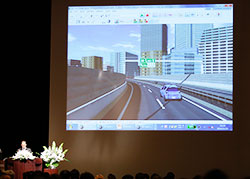 |
 Pencreach Yoann, Pencreach Yoann,
FORUM8 Technical Manager of VR Development Group |
The third special lecture was made by Mr. Sukenori Kobayashi, President of IPG Automotive, entitled "The test system linked with the new VR provided by Virtual Test Drive (use of MIL-SIL-HIL-VIL)".
Firstly, he explained the organization of IPG Automotive that provides
vehicle dynamics simulation (VDS) and solutions for virtual test driving
(VTD) etc., changes in product development over 30 years, marketing expansion
towards establishing a Japanese corporation in the last June, which is
the first overseas branch etc. He talked about challenges and industry
trends in the development area of the automobile industry as well as needs
for building VTD environment, with voices of European users. Then he mentioned
the concept of VTD provided by the company and its original solution, an
overview of its main three products (CarMaker, MotorcycleMaker, and TruckMaker),
elements that the company considers necessary for VTD, and noteworthy open
integrated platforms. Subsequently he mentioned the present situation that
diversified and advanced simulation as well as analysis and verification
are realized and linked to actual development through linking with tools
of other companies or integration with various models by means of the "X
in the Loop" approach of the Company, such as Model-in-the-Loop (MIL),
Software-in-the-Loop (SIL), Hardware-in-the-Loop (HIL), and Vehicle-in-the-Loop
(VIL) etc. Furthermore, he also talked about support cases for the real
driving emissions test (RDE) and the advanced driving assistance system
(ADAS).
 |
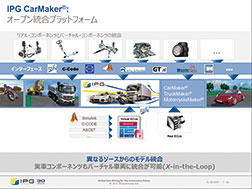 |
 Mr. Sukenori Kobayashi, President of IPG Automotive Mr. Sukenori Kobayashi, President of IPG Automotive |
Mr. Hiroshi Fujiwara, Advisor of FORUM8 Co., Ltd. / Former Honda Motor
Co., Ltd. RAD gave Greetings from an adviser, entitled "The future
of vehicle development generating user's thrill and pleasure". After
looking back his efforts in Honda Motor, based on the present situation
that the automobile market in Japan ranked the 3rd next to China and USA,
he proposed challenges as follows: 1) Can Japanese auto manufacturers lead
automobile development with eyes fixed on the future? 2) How to quantify
the feeling area concerning automobiles? 3) Can the Japanese automobile
industry, in which light automobiles occupies 40% of the automobile market
share, realize downsizing that can be accepted in the world? He showed
expectations towards the future.
 |
 Mr. Hiroshi Fujiwara, Advisor of FORUM8 Co., Ltd. / Mr. Hiroshi Fujiwara, Advisor of FORUM8 Co., Ltd. /
Former Honda Motor Co., Ltd. RAD |
The second presentation made by FORUM8 staff was entitled "The latest information about FORUM8 DS solution". Mentioning the Diverse lineup of UCwin/Road-based DS and recent unique examples of introduction and proposals, he talked about functions of UC-win/Road that are useful for DS, such as the multi-driver function through extension of the cluster system (Ver.9), extension of the traffic simulation function, extension of log output plug-in (Ver.9.1 so far), Oculus Rift plug-in, driving diagnosis plug-in, Aimsun-link plugin, and Kinect plug-in extension (Ver.10), as well as various DS-related solutions such as VR-Cloud® and originally-designed hardware "Ultra Micro Data Center®".
The sessions were closed with a presentation made by FORUM8 staff, entitled "Case examples about developing VR Driving Simulator". He explained the configuration of DS-related areas to link with UC-win/Road, procedure of building DS, functions developed for DS, and UC-win/Road SDK (Development Kit).
 |
 |
 Katsumi Matsuda, FORUM8 Executive officer, Katsumi Matsuda, FORUM8 Executive officer,
Manager of System Sales Group |
 Takuya Miyamoto, Takuya Miyamoto,
FORUM8 System Development Group |

VR Applications Move onto the Next Stage, Wider Circle to be Expected
In the morning of Design Festival Day 2, <General Sessions> that also constitute the "15th UC-win/Road Conference" were held in the hall of Shinagawa Intercity. The opening lecture was followed by the announcement of prizewinners for the "13th 3D VR Simulation Contest on Cloud" and the award ceremony were held.
General Sessions opened up with a special lecture given by Professor Edwin R. Galea from University of Greenwich, Founding Director of Fire Safety Engineering Group (FSEG) entitled "EXODUS/SMARTFIRE - The Latest Research on Fire Analysis and Evacuation Analysis and Case Studies".
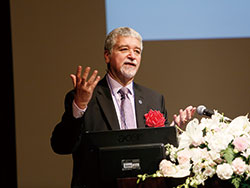 |
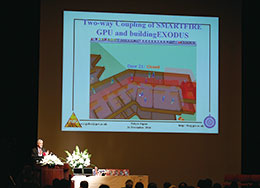 |
 |
 Professor Edwin R. Galea, University of Greenwich, Professor Edwin R. Galea, University of Greenwich,
Founding Director of Fire Safety Engineering Group (FSEG) |
Book written by Prof. Galea (released on that day), "BeSeCu" |
He first gave an outline of the organization of FSEG that he leads, modeling about safety and security studied there, and development of software covering various areas such as the evacuation simulation "EXODUS" and fire simulation "SMARTFIRE". He presented the main application areas of these software programs, experiments for collecting data, and examples of simulation they created. To show just a few of them, items he explained included an effective use of a lift in evacuation from high-rise buildings like WTC, which had produced a large number of victims, way finding (escape route guidance) and signage approaches, examination of the effect of using bollard (car stop), different types of simulation for large-scale crowd and disasters with associated evacuation, fire and human behavior, and studies on evacuation from a large ship or passenger airplane etc. He also mentioned advanced simulation through supporting GPU, expectation to improvement of evacuation plans through using these tools, and importance of quantification of data and human behavior.
The lecture was followed by the result announcement and award ceremony of "The 13th 3DVR Simulation Contest on Cloud". The MC was Mr. Satoru Machida, Advisor of Projection Mapping Association of Japan / CEO of AmbientMedia / Part-time advisor of FORUM8. The nominated works and winners decided at the final judgment held on November 18 prior to the Design Festival were introduced. Finally, Professor Fumio Seki, Department of Civil Engineering, College of Science and Technology, Nihon University reviewed the contest on behalf of the judges. He showed expectation towards wider circle in consideration of the level of entries as a whole getting higher and higher each time and that senior high-school students were not only nominated but also got an excellent prize (semi-grand prix) for the first time.
This contest was founded when UC-win/Road won the prize of "Software
Product of the Year in 2002. This time, 11 entries were nominated out of
all entries through the preliminary qualifying competition held on November
4. The nominated entries were opened to public using VR-Cloud®, for which
general voting was held (November 8-16). Votes were added from three Members
of FORUM8 judging committee (Prof. Seki; Mr. Hiroo Kasagi, Representative
of Chiikizukuri Kobo (NPO); and Mr. Tatsuoki Inagaki, Chairperson of the
board of directors of Pave & Road How-To Way Technology Association.
The results of final judgment were decided on November 18.
 |
 Award ceremony Award ceremony |
The prizewinners of the13th 3DVR Simulation Contest on Cloud and their
entries are as follows.

|
|
"Cooperative ITS Driving Simulator"
TOYOTA MOTOR CORPORATION |
|
|
"Cooperative ITS" aims to realize a safe traffic society through
vehicle-to-vehicle and road-to-vehicle communication. To allow people to
have a virtual experience of this system at the showcase of ITS World Congress
in Detroit, expressways and streets in downtown of Detroit are reproduced
with high precision and reality. Combining with hardware with 6-axis motion
platform makes the sense of reality stronger. |
|
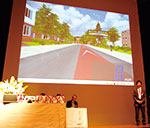 |
|
|
|
"Simulation for environmental upgrading around Higashi Takase River"
Fushimi Technical High School in Kyoto |
|
|
The team focused the research on improvements to the surrounding environment of Higashi Takase River flowing along the west side of the school. Based on the public hearing and questionnaire conducted for the community residents, they simulated the river environment that the community need. With a theme of "River that brings people together", they devised an improvement plan designed for an integrated environment that incorporates a park located in the premise of an apartment building. |
|
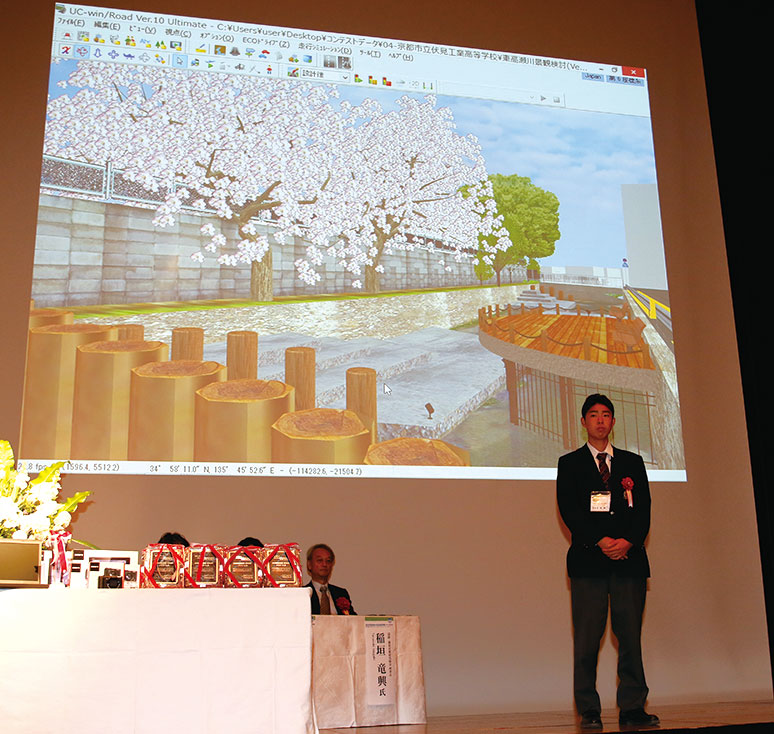 |
|
|
|
"QuikDeck Promotion VR Data"
Nisso Industries Co., Ltd. |
|
|
This VR data was designed for the promotion of a new type of scaffolding constructed in a new manner. Parts for a plant or bridge beams were modeled to highlight its strong features that no other product has. By allowing human models to interact with the moving scaffolding, the workflow of assembling the scaffolding can be confirmed. |
|
 |
|
|
|
"DSSS Experience VR Data"
UTMS Society of Japan |
|
|
This driving simulator is designed to have general public experience driving
through roads equipped with Driving Safety Support Systems (DSSS), one
of the ITS mechanisms. The driver can drive along several courses that
reflect actual roads and choose one of 6 different types of event scenarios.
Representation is visually arranged for users so they can see the effect
of DSSS by comparing the behavior of the vehicle with the one without the
system. |
|
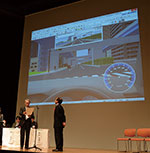 |
|
 |
Design Award
Professor Fumio Seki, Department of Civil Engineering, College of
Science and Technology, Nihon University |
|
|
"Residential Building Design VR Simulation for N House"
atelier DoN |
|
|
VR is applied to housing design. It was used not only for exterior and
interior design but also for checking the view from the surrounding in
terms of privacy security. CFD analysis was separately conducted and the
temperature distribution and wind flow via air conditioning system were
visualized. It was also used for site check with AR. In the future, VR-Cloud®
will be used for consultation with the owner. |
|
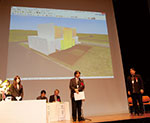 |
|
 |
Accountability Award
Mr. Tatsuoki Inagaki, Chairperson of the board of directors of Pave &
Road How-To Way Technology Association. |
|
|
"Construction VR Simulation for the bridge replacement"
SOZOTECH |
|
|
3D simulation was created to visualize the entire process of a bridge replacement construction work over a second-class river. It includes visualization of the detour plan during the bridge replacement work, nighttime works to install and build the girder of the superstructure, and the plan to divert traffic due to construction. Situations of nighttime construction and visibility of a driver driving on a detour can be verified within the 3D VR environment to contribute to smoother discussion with stakeholders and consensus building with the residents. |
|
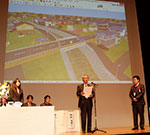 |
|
 |
Community Improvement Prize
Mr. Hiroo Kasagi, Representative of Chiikizukuri Kobo (NPO) |
|
|
"Onuma Floating Islands landscape simulation"
Sanyu Eng. Ltd |
|
|
ONUMA-NO-UKISHIMA (Onuma Floating Islands) located in Asahi-cho, Yamagata Prefecture in Japan, are said to have been discovered in 681.
The pond, shaped like a gourd dotted with about 60 islands, was designated as a National Scenic Area. With the order-receiving for perimeter survey of the pond as a start, they represented the area including Inari shrine and Kasasagi bridge with VR aiming to hand down the situation of floating islands to future generations. They made the data more realistic by laying point cloud data on it. |
|
 |
|
|
"Driving support agent VR simulation"
Doshisha University |
|
|
| This data is intended to research development of next-generation cooperative driving support agent simulation via VR environment. A movable 3D measurement system make it possible to create VR data based on the measured point cloud information and to reproduce the inside of the campus which is used as a testing site for sensing a high degree of accuracy. The advanced research can be now conducted by equipping with a driving simulator with the parts of actual vehicle and an omnidirectional camera / laser unit and building the system combined with a micro-mini electric vehicle which can be automatically advanced controlled. |
 |
|
|
"G'EduCom in Bordeaux"
ITS Bordeaux La CUB & BMIA |
|
|
| The realistic immersion of the users allows to test without constraints
their reactions in front of various situations: accident, pedestrians'
crossing, difficult weather conditions, heavy traffic... Wit h a touchpad
command interface the trainer checks the whole simulation via a simple
interface. He can inject events into various places of the driving route,
modify weather conditions, etc.... He can also ask questions (MCQ) to the
trainees through their own interactive tablet that they can use to interfere
with the VR as well as answering the questions. A full report of the training
session with C02 equivalent emission, fuel consumption and time reactions
to event is available on real time. |
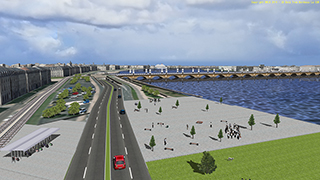 |
|
|
"Redlands California Flood Analysis Project using VR"
Michael Baker International |
|
|
| The downtown area of Redlands has been plagued by flooding with water of
over 1 to 1.75 meters in depth contributed by four major watersheds that
surround the area and undersized aging infrastructure incapable of handling
water of such depth flooding from the watersheds for over 125 years. The
City of Redlands requested a comprehensive study to identify potential
improvements and their potential impacts whose results can be used to establish
flood risk maps in addition to establishing a basis for future Drainage
Impact Fees, and a solution can support public approval. In response to
this, Michael Baker International, in the course of the project ordered
by their client, analyzed the flood hazards within the Redlands area larger
than 2 square kilometers for the 100-year storm event, and the risks associated
with not improving the existing storm drain infrastructure with the DTM
surface that is linked to the City's existing subsurface storm drain system
by creating a 1D/2D hydraulic model using xpswmm (a comprehensive software
package for dynamic modelling of stormwater, river systems, floodplains,
and sewage systems), and imported the analysis result into VR-Design Studio
to graphically show the flood hazards and the risks as 3D animation. Sketchup
building models, detailed aerial photograph, roads, trees, lights, and
a railroad were also included in VR-Design Studio's 3D environment to make
the scene even more realistic. The 3D-hybrid animation created through
this project depicting a link between xpswmm and VR-Design Studio were
also presented in an International Floodplain Conference, and successfully
play a big role of building consensus among the stakeholders and communities
to increase the city's Drainage Impact Fees. |
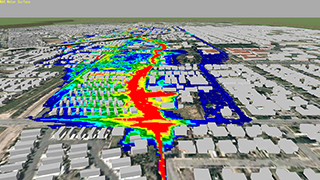 |
|
|
"Tokyo Metro Simulator"
Tokyo Metro Co., Ltd. |
|
|
| VR data created for the driving experience simulator for showcasing at a PR facility. The both up and down trains from Nishi-Kasai Station to Minami-Sunamachi Station on the Tokyo Metro Tozai Line is expressed in VR environment. It is possible to experience driving to the next station and even passing on a bridge and in a tunnel. Evaluation will be displayed according to how accurate the driver could stop the train via Scenario Function. |
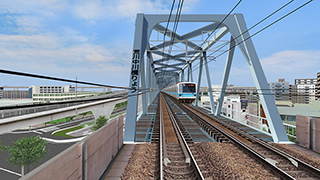 |
|
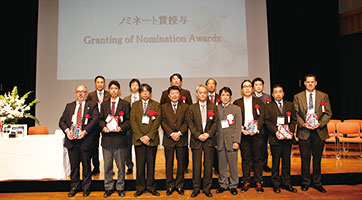 |
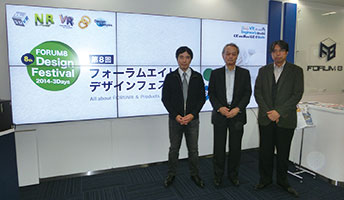 |
 Nominate Award Winners Nominate Award Winners |
 From the left) Mr. Hiroo Kasagi, Mr. Tatsuoki Inagaki, and Mr. Fumio Seki
(president of the judging committee) From the left) Mr. Hiroo Kasagi, Mr. Tatsuoki Inagaki, and Mr. Fumio Seki
(president of the judging committee) |

Presentations and Proposals by Experts and Students In and Out of Japan
in the Areas of Architecture, Civil engineering, and ICT
"The 8th Design Conference" <IM&VR Sessions>, held in the Hall in the afternoon, opened up with "the open final judgment of the 4th VDWC (virtual Design World Cup)/ the 2nd CPWC (Cloud Programming World Cup)". "VDWC" is an international competition for students to design architecture and urban cities using FORUM8 software on BIM/CIM and VR including UC-win/Road. Being the 4th this time, a proposal theme was set to "Sustainable Olympic Town in Tokyo Bay 2020: Shinkiba and Tatsumi Area". On the other side, "CPWC" is a competition for programming techniques of cloud application that can run on VR-Cloud® using UC-win/Road SDK (Software Development Kit) and VR-Cloud® SDK.
The open final judgment of both WCs started with MC by Mr. Ryuta Ieiri, a Construction IT journalist. First, Prof. Yasushi Ikeda, Chief of VDWC executive committee (Professor of Graduate School of Media and Governance, Keio University / Representative of IKDS), Mr. Yoshihisa Hanamura (Director of NPO Civil Machizukuri Station / Vice-chairperson of Liaison Council of Construction NPOs), Prof. Kostas Terzidis (Associate Professor at Harvard University), and Prof. David Tseng (National Chiao Tung University, Taiwan / Representative of CitiCraft architectural office). Prof. Ikeda explained the points of the theme of VDWC this time, and the process of selecting the nominated works from entry phase through preliminary selection. Mr. Ieiri mentioned the history of VDWC and its concept. Then each team made the presentation of the nominated work. Lastly, judges gave their impressions respectively and made final vote.
 |
 |
 Prof. Yasushi Ikeda, Chief Prof. Yasushi Ikeda, Chief
of the 4th VDWC executive committee
and other judges |
 Prof. Tomohiro Fukuda, Prof. Tomohiro Fukuda,
Chief of the 2nd CPWC judging committee |
With a similar procedure successively, Prof. Tomohiro Fukuda, Head of CPWC
judging committee (Associate Professor from the Graduate School of Engineering
Osaka University) and other judges were introduced, including: Hiroyuki
Hakura (Delegate of "The Forum for Advancement of Stereoscopic Three
Dimensional Image Technology and Arts" / Designated Professor of Digital
Hollywood University, Graduate School), Prof. Taro Narahara (Associate
professor from the College of Architectural Design, New Jersey Institute
of Technology) , and Yoann Pencreach (Chief Manager of VR development group,
FORUM8). Prof. Fukuda, Chief Judging Committee summarized the overview
of CPWC, judging points, judging process and the process of selecting the
nominated (6) entries. Subsequently, each team made presentation before
the final vote was made.
Following the open final judgment, the first special lecture of <IM&VR
Sessions> was "Developing process - from information technology
to designing space -" given by Prof. Takehiko Nagakura, Associate
Professor of School of Architecture, Massachusetts Institute of Technology.
He first presented some of his studies such as experimental digital representation
of structures not actually constructed, named "Unbuilt Monuments",
and CG movie production technology. After mentioning historical changes
in digital design tools, he moved onto several topics such as projects
for digital visualization of Built (what actually exists), to which he
shifted his interests from Unbuilt, with many different technologies; exploration
of how to utilize data obtained by such projects, case studies of tool
development for information useful to design using advanced ICT (research
of impressions of towns, expression of access time, simulation of human
behavior, and various ways of showing design). In addition, he developed
his talk into Website for conducting competition of smallscale architecture
projects such as renovation with of worldwide architects as participants
(arcbazar.com), and "the world of architecture with more fun"
to be realized through a new way of competition.
Lastly, based on the fact that systems themselves are becoming more intelligent in the future, he mentioned the future direction of his own studies, namely, generation of design or interpretation and comments about it using those systems.
 |
 Prof. Takehiko Nagakura, Prof. Takehiko Nagakura,
Associate Professor of School of Architecture,
Massachusetts Institute of Technology |
Next, Mr. Toshiro Kawamura, Former vice president of NEC, President of
Collabo Business Consulting, and Advisor to FORUM8 gave a special lecture
entitled "Recommendation for ICT Global Collaboration". Since
his new book, of which title is the same as the lecture, was published
by FORUM8 on the day, he presented the process of publication.
Then he showed his ideas about several topics: historical streams of computer-related diverse technologies and development of super computers and PC, business style of 21st century based on network and challenges with it, response to diversity and globalization, an approaches to collaboration.
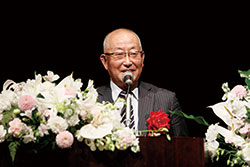 |
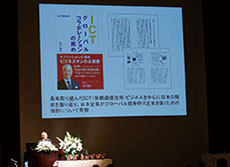 |
 Mr. Toshiro Kawamura, Mr. Toshiro Kawamura,
President of Collabo Business Consulting and Former vice president of NEC |
Prof. Zhen-jiang Shen, Professor at School of Environmental Design, College
of Science and Engineering Kanazawa University gave the last special lecture
in the first half, entitled "VR technology for supporting urban design".
Mentioning his activities of supporting plans using VR and GIS mainly in
his local area Kanazawa, he summarized the features of VR as a tool, and
the process of plan supporting activities for residents using it. Then
he explained a method developed to visualize regulations of Building Standards
Act that are hard to understand in text to allow the residents and students
to study it; case study of applying it to participation of residents in
the examination process of a local government, and evaluation of approaches
through them. Lastly, he developed his speech to the future research themes
such as utilization of big data in urban design, and a study on setting
parameters to represent buildings that comply building regulations with
UC-win/Road.
 |
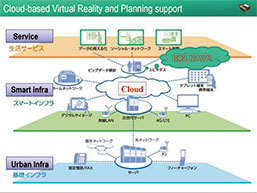 |
 Prof. Zhen-jiang Shen, Professor at School of Environmental Design, Prof. Zhen-jiang Shen, Professor at School of Environmental Design,
College of Science and Engineering, Kanazawa University |
After a break, the second part of the afternoon started with presentation
by FORUM8 staff entitled "IM&VR solution and 3DVR engineering
service". He outlined the links of BIM/CIM support solutions of FORUM8
with UC-win/Road as a platform among applications. He illustrated links
between UC-win/Road and different analysis results such as wind analysis,
point cloud analysis, and energy analysis. He explained some functions
of UC-win/Road Ver.10 and 3D CAD Studio under development with demonstration.
Moreover, he mentioned related services including the future response to
BIM/CIM solutions and 3D VR engineering services.
 |
 Masayoshi Tatsumi, VR Support Group, FORUM8 Masayoshi Tatsumi, VR Support Group, FORUM8 |
The sessions were closed with "Award Ceremony for the 4th VDWC / 2nd CPWC" moderated by Mr. Ryuta Ieiri, and with Reporter Mr. Yuji Abe as MC.
15 entries that received nomination prizes were presented and awarded with
the prize. Then judges (Prof. Ikeda Chief executive committee, Mr. Hanamura,
Prof. Terzidis, Prof. Tseng) announced the following prizewinners and awarded
prizes with comments: "Judge's special prize, Sustainable design prize"
(Robert Gordon Univ.); "Ditto, Civil design prize" (Tokyo Univ.
and Yamaguchi Univ.); "Ditto, Foresight prize" (Shibaura Institute
of Technology and Graduate School); "Ditto, Top of the world prize"
(Ritsumeikan Univ.); "Excellent prize" (University of Transport
and Communications (Vietnam)), and "World cup prize" (Kanazawa
Univ.).
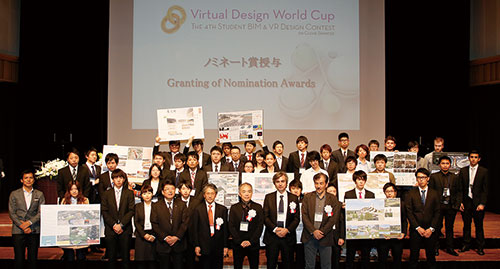 |
 Prizewinners of VDWC Nomination Prize Prizewinners of VDWC Nomination Prize |
Next, presentation of 6 works that received Nomination prize of CPWC was
made and the prizes were awarded. Then the judges (Prof. Fukuda Chief judging
committee, Prof. Hakura, Prof. Narahara, and Mr. Yoann) announced the following
prizewinners and awarded the prizes with comments: "Judge's special
prize, Environmental design informatics prize" (Sugiyama Jogakuen
Univ.); "Ditto, No man car / automatic driving car prize" (Kyushu
Univ.): "Ditto, Cloud sourcing prize" (Shanghai Maritime Univ.);
"Ditto, Real world application prize" (Kansai Univ.); and "World
cup prize" (Shanghai Jiao Tong University). Finally Prof. Nagakura,
Prof. Galea, and both chiefs of WC executive committee deepened discussion
and closed the sessions.
 |
 Prizewinners of CPWC Nomination Prize Prizewinners of CPWC Nomination Prize |

| Title : The S.T.A.R.S. (Sustainable Taches and Reactivate Space) |
| Team Name : KUUPL |
|
| University Name : Kanazawa University |
Country : Japan |
|
| The S.T.A.R.S "Sustainable Taches and Reactivate Space" is a planning concept of Tatsumi region which includes adding new city facilities and adjusting land use, to meet the need of 2020 Olympic Games in Tokyo, Japan. This plan is hoped to provide easy mobility and comfortable stay for visitors from around the world and to live up to the expectation for its regeneration into an advanced environmentally friendly city. The Sustainable Taches concept will ensure the serving of the needs in accommodation transportation and entertainment for the visitors during the Olympics, and also could be used effectively by the local after the Olympics, which avoids unnecessary investment and excessive financial burden. The Reactivate Space concept tries to promise the development of the harbor region out of the image of a industrial waterfront and offers an attractive and valuable environment in the perspective of landscape design. The S.T.A.R.S. aims to achieve environmental conservation, sustainable development, to maximize the cost performance in both ecological and scenic sense in Tatsumi region. (In order to operate the script in UC-Winroad in a normal speed, the models are simplified in quite a extent in VR data.) |
|
|
|
|
| Title : Tokyo_Sustainable Development |
| Team Name : INED_UT |
|
| University Name : University of Transport and Communication |
Country : Vietnam |
|
| Tokyo is striding towards 2020 Olympics, then it requires a careful preparation
that leading to not only a successful Olympics but also the powerful promotion
of Japanese beauty to the world. Coming to the competition, INED team would
like to make the ideas about the urban planning, transport system renovation
for the region Shikiba/ Tastumi, in which the Olympics will take place;
in order to ensure the comfort and convenience for the visitors over the
world. One of the important things that we concern is the sustainable development
for the future of Tokyo Bay.The highlight of our work in transport planning
is using the Modern Roundabout intersection which replaces Circle Traffic
or Rotary ones which are used in the area.Besides, we propose to build
new bridges so as to ensure the traffic and avoid the congestion when people
flock to this place in Olympics. Coming to this competion, INED team contributes
these ideas in order to solving the planning problem as well as saving
the energy that is towards the sustainable development in Tokyo Bay in
particular and beautiful country Japan in general. In the spirit of exchanging
and learning, we hope to receive comments and criticism of the contest's
Organizing Committee and everyone to improve and develop these ideas. With
the desire to be able to apply ideas into practice, creat friendly architecture,
the beautiful symbol for beloved country Japan. |
|
|
|
|
 |
|
Judge's Special Prize
Prof. Yasushi Ikeda
(Graduate School of Keio University / Chief of executive committee of VDWC / Representative of IKDS) |
| Title : Connected Yumenoshima, Optimised Circulation for the Olympics |
| Team Name : International Architectural Think Tank Inc. |
|
| University Name : Robert Gordon University |
Country : U.K. |
|
| Focusing on aiding the existing connections for streamlined operation and
efficiency, through designing new infrastructure at key transportation
nodes. This will allow for simple and safe pedestrian movement around dense
and fast paced vehicular routes. Proposing an integrated tram service throughout
the Olympic site to provide a quicker alternative to walking that reduces
traffic and pollution in the immediate area. Lowering the Meniji Dori road
that cuts through the Olympic site, allowing smooth connections between
the venues on the new hard landscaped pedestrian routes. The proposed tram
route will also benefit from the lowering of the road, to avoid delays
in the flow of the low impact service. |
|
|
|
|
 |
|
Judge's special prize
Mr. Yoshihisa Hanamura (Director of NPO Civil Machizukuri Station)
/ Vice chairperson of Civil NPO Collaboration Platform) |
| Title : gather |
| Team Name : T.O.F.U |
|
| University Name : Tokyo University + Yamaguchi University |
Country : Japan |
|
| This project proposes new Shinkiba station and a mobility system to make
the situation before, during, and after the "Tokyo Olympic 2020"
better than now. First, their master plan shows the traffic line for people
from Shinkiba station to leisure facilities. The mobility system is arranged
along the traffic line for people. Second, 11 eco-stations are in the mobility
system. They are sustainable buildings. |
|
|
|
|
 |
|
Judge's special prize
Prof. Kostas Terzidis
(Associate Professor, Harvard University, USA) |
| Title : Walkerizing City |
| Team Name : shellfish |
|
| University Name : Shibaura Institute of Technology Graduate school of Shibaura Institute of Technology |
Country : Japan |
|
| "Walker-izing City" is proposed in this data. This city will
be aging with people, and transformed suit to them. At the end of Olympic
games, this city will transform to health and welfare-oriented city that
is friendly to handicapped and old people. The construction & traffic
management are performed on the platform comprised of data based on BIM
available on cloud for designers, constructors, administrators, and inhabitants
to use. The city has cloud server which can be used. When city construction
begins, design scheme is uploaded to the server. Inhabitants can then check
design scheme or comment on it as and when required. This way, the scheme
can be clarified for everyone, leading to a consensus. And when the city
transforms itself, these types of information will be exploited. |
|
|
|
|
 |
|
Judge's special prize
Prof. C David Tseng (National Chiao Tung University, Taiwan /Representative
of CitiCraft architectural office) |
| Title : √SHINKIBA |
| Team Name : DDP |
|
| University Name : Ritsumeikan University |
Country : Japan |
|
| √ means roof and root in this proposal. We analyzed traffic lines around the Shinkiba and designed wooden frames as √. Wooden frames play two roles during the Olympic games and after the games. During the Olympics, a large number of people give their support to the athletes or walk between the stations and facilities under wooden frames. After the Olympics, wooden frames are distributed around Shinkiba as a resting place for neighbors. They are installed in appropriate places based on the prediction of the flows of visitors. The frame design brings people comfortable wind and shade. The materials for efficient construction are integrated intelligently for an ideal design. |
|
|
|
|
"Igune Learned
from to Igune"
Thunder

|
"The "Walkatblue"
City,Tokyo."
Miyashita Laboratory

|
"Waterfront paradise"
Max Power
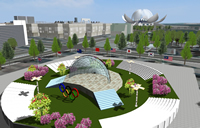
|
"Sakura Transit Station"
Light Taipei
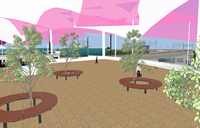
|
"Sapiential Olympic"
Chengcheng

|
"The eco-boat which connectsthe land and the sea"
navigation N

|
"The town which can grow up with a tree"
BULLS
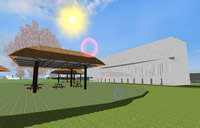
|
"SKY WALKING"
Esthys

|
"Telexistence stadium"
TEAM SHIN-KIVIR
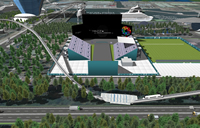
|
|
|

| Title : Kinect Smart Drive |
| Team Name : Great Sword |
|
| University Name : Shanghai Jiao Tong University |
Country : China |
|
Kinect Smart Drive combines Kinect drive and smart drive (automatic assist
drive) together. User can use it in UC-win/Road with a Kinect sensor. Users
who do not have kinect can just use smart drive functions. It is not only
a software plug-in, but also a game system, and can even be used as a great
tool for research on autonomous driving. We hope everyone can have fun
with this wonderful plug-in.
|
|
|
|
|
 |
|
Judge's special prize
Tomohiro Fukuda (Head of judges and associate professor from the Graduate
School of Engineering Osaka University) |
Title : Analysis of drive behavior in shared spaces and
architecture of large scale simulation environments |
| Team Name : Chocolat |
|
| University Name : Sugiyama Jyogakuen University |
Country : Japan |
|
| A virtual city based on an actual roundabout at Ichinomiya, Aichi was constructed
this time. It requires a navigation function which gives instructions to
drivers in the virtual city. In order to realize the navigation function,
our team developed a plugin "Chocolat" which enables to display
navigation instructions by text and image on the screen without any difficulty.
A trigger condition of the navigation instruction is given by X, Y, DX,
and DY where X and Y are position of vehicle, and DX and DY are direction
of vehicle in the virtual city. |
|
|
|
|
 |
|
Judge's special prize
Mr. Hiroyuki Hakura (Delegate of "the Forum for Advancement of Stereoscopic
Three Dimensional Image Technology and Arts" / Designated Professor
of Digital Hollywood University, Graduate School) |
| Title : Building of a test environment for automatic driving systems |
| Team Name : SDL |
|
| University Name : Kyushu University |
Country : Japan |
|
 Overview Overview |
|
There are various studies that aim to make automatic driving systems possible in a near future. As part of this movement, we developed this plugin to assess what kind
of behavior and accidents can happen at converging junctions. This plugin adds traffic indicators to scenario event exit conditions.
|
|
|
|
|
 |
|
Judge's special prize
Prof. Taro Narahara (Associate professor from the College of Architectural
Design, New Jersey Institute of Technology) |
| Title : Openstreetmap import and navigation plugin |
| Team Name : Torneko |
|
| University Name : Shanghai Maritime University |
Country : China |
|
| This plug-in focus on how to make a fast deployment of a road network data
and make it possible for UC-win/Road to do a route navigation. We choose
OpenStreetMap data for the road network data source because it’s free and
fast. We choose VR-Cloud® to achieve the route navigation function because
a user of the data is more likely to use navigation function but not the
designer.. |
|
|
|
|
 |
|
Judge's special prize
Pencreach Yoann
(Technical Manager of FORUM8 VR development) |
| Title : Driving Support Plugin |
| Team Name : Kaisers |
|
| University Name : Kansai University |
Country : Japan |
|
| This plugin allows the reproduction of real world driving and road conditions
in the simulation, using the vehicle control information logged with the
CAN logger. By displaying alerts in situations that leads to traffic jam,
users can use take part in the driving simulation to practice ways to avoid
traffic jams. |
|
|
|
|
「To track pedestrians in the process of evacuation」
Just skyline |
 |
|
|
Also please refer to 3D VR Engineering Service.

An increase in demand for 3D analysis/simulation due to an expansion of analysis target and scale
Mr. Toshiro Hanada, the president of Bulld Geotechno Co., Ltd. who gave
a well received presentation last year opened the curtain of the Geotechnical
Session this year with his special lecture titled "Examples of "GeoFEAS"
Application for analysis of self-weight consolidation settlement occurred
at the time of seismic liquefaction".
 |
 |
 Mr. Toshiro Hanada, president of Bulld Geotechno Co., Ltd. Mr. Toshiro Hanada, president of Bulld Geotechno Co., Ltd. |
The next special lecture was by Mr. Fei Cai; an associate professor in
the Graduate School of Engineering, Gunma University; on "Geotechnical
FEM analysis technology and its case example". He thoroughly described
the design codes implemented in the geotechnical FEM analysis, an outline
of the geotechnical analysis system based on Finite Element Method, and
the various types of geotechnical FEM analysis. With this in mind, he introduced
an actual example of damages done to buildings due to liquefaction during
the 2007 Chūetsu offshore earthquake, and how big of a positive impact
you can make by performing FEM analysis in advance, leaving a strong impression
on the audience about the effectiveness of the pre-analysis.
 |
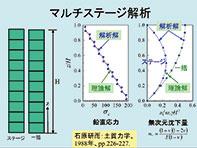 |
 Mr. Fei Cai; an associate professor from the Department Mr. Fei Cai; an associate professor from the Department
of Environmental and Engineering Science, Graduate School
of Engineering, Gunma University |
Ms. Kana Nakatani; an associate professor of Agriculture Department, Kyoto
University who was involved in the development of a user friendly Debris-Avalanche
Simulator " Kanako" whose solver is used in FORUM8's "UC-1
Debris-Avalanche Simulation"; gave her presentation continuing on
from where she left off in her lecture last year. In her presentation titled
"The latest case example of debris-avalanche analysis - An evaluation
that caused a change in the way in which buildings and terrain ought to
be built and set", the following case examples, both of which use
Kanako in the debris-avalanche analysis, were introduced: A debris-avalanche
analysis based on the data from an actual debrisavalanche that occurred
at Toikawa, Aso-city in Kumamoto prefecture in Japan in July 2012; and
the same analysis based on the data from the debris flow triggered by typhoon
no. 26 that struck the Izu-Oshima Island in 16 October 2013. Both were
good examples that illustrated the important points to remember when assigning
a model using "Debris-Avalanche Simulation", providing many users
that attended the session valuable information to take home and use in
the future.
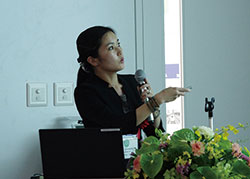 |
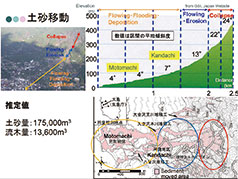 |
 Ms. Kana Nakatani, an associate professor Ms. Kana Nakatani, an associate professor
from the Agriculture Department, Kyoto University |
In following presentation by a representative from FORUM8 Development Group, the latest information on 3D Geotechnical Analysis Series products, new features of Debris-Avalanche Simulation, and the newly released product FEM Engineer's Suite was presented.
He emphasized on how the ability to represent analysis results in 3D model unique to FORUM8 products can be very useful in verifying the analysis results. He went on to explain the advantages of UC-win/Road in particular its ability to build and visualize analysis models quickly and easily, and to reproduce multiple debris-avalanche simulations simultaneously, forecasting a promising future in the discipline of debris-avalanche analysis.
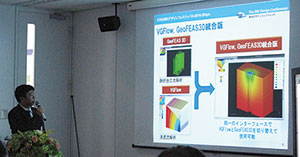 |
 Yoshiaki Mizuno, UC-1 Development Group 1, FORUM8 Yoshiaki Mizuno, UC-1 Development Group 1, FORUM8 |

Basic technology of Resilience, A Variety of Solutions
The morning part of <Design, Analysis and Seismic Sessions> held
in the Hall opened up with a special lecture of Prof. Satoshi Fujii, Professor
of Kyoto University Graduate School of engineering, Department of Urban
Management, entitled "The latest National Resiliency". He mentioned
the present situation of Japan pressed to respond to large-scale natural
disasters that frequently occur including earthquakes and flood disasters,
as well as deterioration of infrastructure, and the significance of policies
to build advanced resilience. Then he summarized the process of how Fundamental
Plan for National Resilience, which he strived developing as Special Advisor
to the Cabinet for the second Abe Cabinet, reached cabinet decision in
June 2014. He explained the significance of the Fundamental Plan and the
concept of resilience, and in particular, positioning of "Achieve
swift recovery and reconstruction" and the idea of "Disaster
Prevention and Mitigation New Deal", and their political implication.
Further, he said diversity of different regions should be restructured
and collaboration among regions be strengthened. At the same time, vitality
of regions should be increased by promoting building of national robustness
to disasters. Trying to free the country from Tokyo centralization, it
should be aimed to form national land of "self-control, dispersion,
cooperation"-type. Like this, he insisted on importance of the viewpoints
towards building national resilience. He also mentioned the idea of creation
of locality linked with expansion of Shinkansen bullet train network as
part of its specific measures.
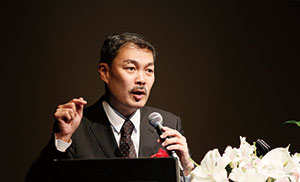 |
 Prof. Satoshi Fujii, Prof. Satoshi Fujii,
Professor of Kyoto University Graduate School of engineering,
Department of Urban Management |
Following the lecture, announcement of prizewinners and an award ceremony
of "the 1st National Resilience Design Award", which was founded
in 2014 aiming to honor the efforts to contribute to building national
resilience. This covers the fields ranging from structural analysis (civil
engineering and architecture) to geotechnical engineering, hydraulic engineering,
and disaster prevention, aiming to build a place for providing information
and technical training through specific cases leading to national resilience
and competition of the results. Ahead of the ceremony, Prof. Hiromichi
Yoshikawa, Chief judging committee (Professor of Disaster Prevention Engineering,
Tokyo City University) was introduced with other judges, including Prof.
Keizo Ukai (professor emeritus, Graduate School of Engineering, Gunma University
/ Inspector at FORUM8), and Prof. Masaru Morita (Professor, Urban Environmental
Engineering Lab, Department of Civil Engineering, College of Engineering,
Shibaura Institute of Technology).
Chief Judge Yoshikawa explained the concept of the Award and the process of entries through preliminary selection to nomination of (10) works (October) and decision of prizes on November 17.
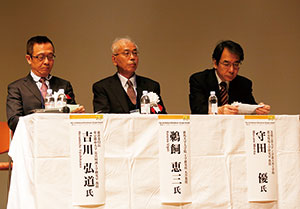 |
 Judges. From the left, Prof. Hiromichi Yoshikawa Judges. From the left, Prof. Hiromichi Yoshikawa
(Chief judging committee),
Prof. Keizo Ukai, and Prof. Masaru Morita |
In the ceremony, 10 works that received nomination prizes were presented with their outlines and points, and the prize was awarded. Judges announced the following prizewinners out of them with comments and awarded the prizes with them: "Judge's Special Award, Flood Risk Management Award" (Azbil Corporation); "Ditto, Geotechnical Construction Method Assessment Award" (Shin Nippon Giken Engineering Co., Ltd., Western branch); "Ditto, Seismic Performance Evaluation Award" (Japan-China Consultant Co., Ltd., Nagoya branch); "Ditto, Environmental Sustainable Analysis Award" (atelier DoN); "Excellent Award" (Yokogawa Sumikin Bridge Corp.); and "Grand Prix" (Tojitsu Sekkei Consultant Co., Ltd.). Finally, Chief Judge Yoshikawa made remarks on the significance of this attempt and expectation towards the future to close the morning sessions.
 |
 Prize winners Prize winners |
The sessions were restarted in the afternoon with Special Lecture "Development
of the comprehensive platform regarding the initial stress analysis of
concrete structures" by Prof. Tadaaki Tanabe, Professor emeritus of
Nagoya University and Executive Director of Chubu Regional Institute of
Infra-Technology Evaluation and Support. Concerning initial cracking of
a concrete structure or control of the crack width, he introduced the activities
of Mass Concrete Software Production Committee of JCI (Japan Concrete Institute),
which he serves as an advisor. He also talked about "JCMAC3",
a program that the committee has been developing as a comprehensive platform
for initial damage analysis and load-carrying capacity under it, and "JCMAC3-U"
(planned to be released within 6 months). Showing the basic theory, various
problems about cracks in concrete structures, and cases of experiment and
analyses by multiple researchers responding them, he expounded effectiveness
of the current tool. In addition, he mentioned an example of load-carrying
capacity analysis of Tarui elevated bridge with LECOM (JCMAC3-U).
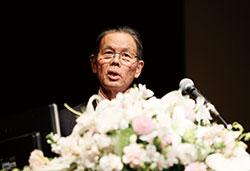 |
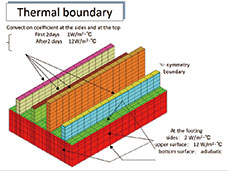 |
 Prof. Tadaaki Tanabe, Professor emeritus at Nagoya University Prof. Tadaaki Tanabe, Professor emeritus at Nagoya University |
Next, Mr. Teisaburo Hanafusa, Mr. Tsuyoshi Yokota, and Mr. Kentaro Fujimoto,
Design Group, Civil Engineering Dept., Civil Engineering Branch, P.S. Mitsubishi
Construction, gave special lecture entitled "Case studies of FEM analysis
for concrete bridges". First, Mr. Hanafusa illustrated the concept
and characteristics of prestressed concrete (PC) and types of PC structures
to which they are applied. At the same time, he mentioned PC bridge design
in the Company and utilization of FEM analysis there. This was followed
by Mr. Fujimoto, focusing on PC 4 span continuous extradoused box girder
bridges. He summarized the features of extra-doused box girder bridges
and points of the specific bridge. He also mentioned studies on diagonal
member anchoring projection for the newly constructed bridge, studies on
straining diagonal members of double chamber box girder portion, and application
cases of FEM analysis in examination during overhang execution. Mr. Yokota
further summed up the increase in needs for repair and reinforcement in
the field of bridges, as well as environment that surrounds construction
works and the present situation. Taking a construction work of replacing
bearings and a bridge girder reinforcing work, he explained overview of
each work, studied contents of FEM analysis, and the result of study. He
gave his view about the advantages of FEM analyses gained through them.
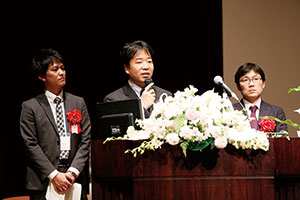 |
 Mr. Kentaro Fujimoto, Mr. Teisaburo Hanafusa, Mr. Kentaro Fujimoto, Mr. Teisaburo Hanafusa,
and Mr. Tsuyoshi Yokota, Design Group, Civil Engineering Dept.,
Civil Engineering Branch, P.S. Mitsubishi Construction |
Subsequently, FORUM8 staff made presentation entitled "The latest
function of Engineer's Studio® and FEMLEEG". After mentioning the
history of revision of Engineer's Studio®, he explained multiple point
input, function of result saving option, and Rayleigh damping expansion.
He also talked about the outline of FEMLEEG and new functions of Ver.5.0
(proper vibration analysis in consideration of initial stress, circular
arc arrangement of creation of embedded reinforcing bar elements, improved
accuracy of low order PENTA elements, varying load within element, function
of saving and calling view information, and function of registering legend
levels).
The sessions were closed with special lecture of Mr. Akihiro Kodama, Director
of Structure Dept., Southern-Tech Co., ltd., entitled "Case study
of seismic reinforcement design of an existing RC fixed-arch bridge".
Firstly he talked about outline of work for an existing RC upper deck type
fixed-arch bridge, detailed research of the bridge and its result, study
on repair based on the result and proposal, and points in considering load-carrying
capacity reinforcement. Then he expounded detailed design of seismic reinforcement
in consideration of particularity of the case, and detailed design of seismic
reinforcement after reinforcement. He also mentioned various challenges
in seismic analysis. Finally, he again explained the importance of 1) visiting
the site and properly grasping the geometrical deterioration and damage
of the present situation when dealing with existing structures; 2) verifying
in what kind of shape the structure will fail; and 3) dealing with the
case faithfully with enthusiasm.
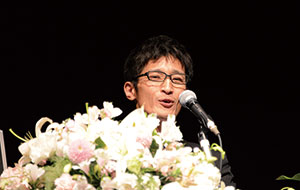 |
 Mr. Akihiro Kodama, Mr. Akihiro Kodama,
Director of Structure Dept., Southern-Tech Co., ltd. |

|
"An examination of the seismic performance of steel strutted-beam
rigid frame bridge older than 40 years and the consideration of the bridge
reinforcement work in line with the New Japan Specifications for Highway
Bridges"
Tounichi Sekkei Consultant |
 |
|
|
|
| Program used : Engineer's Studio® |

 |
PDF poster
(707KB) |
|
| The program was used for the examination of the current condition of steel
strutted-beam rigid frame bridge (built in 1970, with a bridge span of
80m) and the work of increasing the seismic capacity of the bridge. Based
on the results of examining the current condition, the bridge was reinforced
by applying to the cross frames dampers for building base isolation to
minimize the vibration parallel to the bridge axis and braces for constraining
buckling to minimize the vibration perpendicular to the bridge axis in
order to prevent yielding and reduce strain, and cover plates were also
used for the reinforcement as needed. |
|
|
"Examination on the effectiveness of installing braces for constraining
buckling in the case where the bridge vibrates in the direction perpendicular
to the bridge axis"
Yokogawa Sumikin Bridge Corp. |
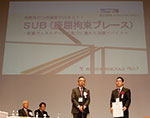 |
|
|
|
| Program used : Engineer's Studio® |

 |
PDF poster
(449KB) |
|
| When performing a dynamic nonlinear analysis on the vibration of an existing
bridge in the direction perpendicular to its axis, generally speaking,
bearings are modeled as fixed models. In this case, the inertia force from
the superstructure is transferred directly to the bridge pier, hence the
damage to the substructure tends to increase. As means of mitigating the
damage of this kind, an analysis model in which braces for constraining
buckling (one of the devices for mitigating seismic motion) are installed
has been built in Engineer's Studio®, and a dynamic analysis was performed
to examine the impact of the nstallation. |
|
 |
|
Judge's Special Award
The 3 judges are Mr. Hiromichi Yoshikawa, Mr. Keizo Ugai, Mr. Masaru Morita |
|
"N project CFD simulation"
atelier Don |
 |
|
|
|
| Program used : DesignBuilder、Allplan |

 |
PDF poster
(374KB) |
|
| CFD (Computational Fluid Dynamics) analysis was performed for a private
house. The surface temperature of wall/window, the air outlet of air conditioners,
and heated floor were all assigned to the big space covering the stairwell
connecting the corridors, and an analysis on the airflow and temperature
at steady state was performed. Based on the analysis results, the capacity
of air conditioners and the optimal place to install them, as well as the
optimal place to install windows and zone dividers were all examined in
order to plan and design an energy saving house with a comfortable and
convenient interior environment. This has been achieved through the use
of the software. An accurate 3D model of the house was exported to BIM
software to be used in designing the house, and its appearance was also
reviewed using VR. |
|
 |
|
Judge's Special Award
Prof. Hiromichi Yoshikawa from Urban Earthquake DisasterMitigation Engineering
Laboratory, Tokyo City University |
|
"Examination of the seismic performance of an arc bridge via dynamic
analysis"
JAPAN-CHINA CONSULTANT Co., LTD. |
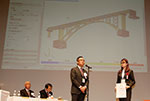 |
|
|
|
| Program used : Engineer's Studio® |

 |
PDF poster
(640KB) |
|
| Engineer's Studio®'s ability to input multiple points were exploited in
the dynamic analysis of an arc bridge to confirm the behavior of the arc
bridge itself and the difference seen in the different types deformation
in the arc abutment. In this case, various types of seismic wave were applied
to get a clear picture of the different kinds of stress and deformation
behavior due to earthquake motion inputted at different places within the
target structure, in order to extract problems likely to occur whilst examining
the seismic performance. |
|
 |
|
Judge's Special Award
Prof. Keizo Ugai from the Graduate School of Science and Technology, Gunma
University |
|
"An analysis on the effect of an earthquake on bridge piers installed
within the embankment (pier abutment)"
Shin Nippon Giken Engineering Co., Ltd., Seibu Branch Office |
 |
|
| |
| |
| Program used : Dynamic Effective Stress Analysis for Ground (UWLC) |

 |
PDF poster
(827KB) |
|
| For the embankment in which bridge piers are to be installed as part of
the plan to build a new bridge, the behavior of dynamic vibration transmitted
from the bridge to the ground in the event of an earthquake has been assessed
quantitatively via FEM analysis. In the course of modeling the bridge piers,
bridge pier columns and footings, along with the cross section size of
foundation piles and material properties have all been reproduced in the
analysis mesh, which in turn lead to the acquisition of results with an
accuracy higher than the results obtained from a normal bar model analysis.
Based on these results, the embankment and ground in which bridge piers
and sheath pipes are to be installed has been proved to be safe even in
the event of an earthquake. |
|
 |
Judge's Special Award
Prof. Masaru Morita from College of Engineering, Shibaura Institute of
Technology |
|
"An analysis of inundation within the premise of a factory and its surroundings considering the collapse of levees along a nearby river"
Azbil Corporation |
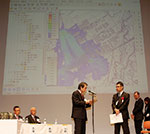 |
|
|
|
| Program used : xpswmm |

 |
PDF poster
(2,139KB) |
|
| The flood risk map in the official website of a municipality where the factory of Azbil Corporation is situated predicts the area downstream likely to be inundated on the assumption that levees along a particular river were to collapse due to the water level rise in the river, but lately there has been some doubt as to whether or not the flood risk map over predicts the consequences. A detailed flood and inundation analysis has been performed on the premise of the factory and its surroundings as to produce a more accurate flood risk map showing the scene of flood to understand the real effects. The analysis result visualized in the new and genuine flood risk map will be used for measures for BCP (Business Continuity Planning) put into practice by the factory. |
|
"Examination on the seismic performance
of sluice gates of a seawall"
RATECH.CO.,LTD.
|

 |
PDF poster
(464KB) |
|
"An analysis on the deformation of levees along a river considering
the effect of liquefaction"
Kyushu Kouei |

 |
PDF poster
(509KB) |
|
"Examination on the impact of ground response analysis using UWLC"
Wakasuzu Consultants Co.,Ltd. |

 |
PDF poster
(509KB) |
|
"Examination on the effect of installing a box culvert with a large
cross section on a slope with an oblique angle"
SHOWA CONCRETE INDUSTRY CO. ,LTD. |

 |
PDF poster
(822KB) |
|
|

Changes in Introduction of CIM, Current Situation of its Utilization, and
Future Approaches
The second part of afternoon on Day3 was allotted to <CIM Sessions>
held in the Hall. Mr. Seigo Ogata, Senior Engineer, Technology Research
Department, Advanced Construction Technology Center gave a special lecture
entitled "Approach to CIM field and the latest trend". Firstly
he generally described the organization of the Center and his own duties,
and CIM-related activities in Japan Society of Civil engineers. Then he
illustrated main events about CIM in Japan since 2011 and how the Center
was involved with them, the concept of CIM and its changes, main activities
of the CIM System Investigative Commission / the CIM Technical Investigative
Commission, and the Center's involvement with them.
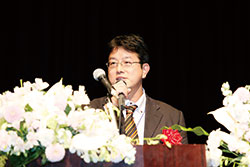 |
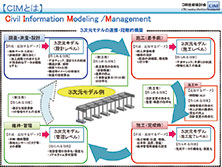 |
 Mr. Seigo Ogata, Senior Engineer, Technology Research Department, Mr. Seigo Ogata, Senior Engineer, Technology Research Department,
Advanced Construction Technology Center |
Regarding the team to research CIM in the U.S.A. sent last fiscal year,
he summarized its purpose, cases of applying BIM in the U.S., efforts on
COBie, an American maintenance system that attracted attention, the idea
of focusing on "visualization" and "process simulation"
reflecting the result of visit. He moved onto the cases commissioned to
the Center in fiscal 2013 (studying design, PM, and research) to which
3D was applied. He also explained the stream towards starting research
on COBie in Japan reflecting the trend research on British Government to
which FORUM8 cooperated, study on scenarios of introducing CIM for higher
efficiency, and CIM application for the commissioned work in fiscal 2014.
In addition, after mentioning the actual situation of activities for dissemination
and education, he expounded his voluntary studies such as utilization of
communities, research on the sites for implementation, utilization of 3D
virtual sites towards improving efficiency of maintenance, linking information-oriented
construction with CIM, CIM study group activities in Kyushu Region, and
CIM Champion lectureship. Finally, he urged what kind of attitude to take
for approaching to CIM.
To close the sessions, FORUM8 staff made presentation entitled "CIM
technology information and case study of technical support services".
As an application case of IM&VR data link, he explained link functions
of FORUM8 software products including different analysis programs, CAD,
and evacuation analysis with UC-win/Road as the core. He also showed specific
examples of: application of point cloud data measured by the laser scanner
to 3D modeling on UC-win/Road, visualization of wind analysis and noise
analysis on UC-win/Road, and simulation of flood and debris flow. He developed
his presentation into the situations of using the VR-Cloud® service.
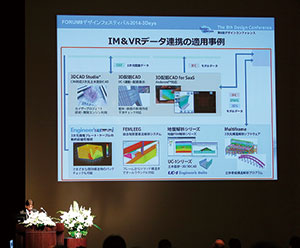 |
 Kazuyuki Tomioka, Group Manager, Kazuyuki Tomioka, Group Manager,
Analysis Support Team of UC-1 Development Group 1, FORUM8 |

Measures for heavy rainfall disasters occurring frequently in the recent
years are the common issues
Water Works Session kicked off with a lecture titled "Case studies
via xpswmm" by Hideaki Yamaga of Nihon Suiko Sekkei Co., Ltd.. Mr.
Yamaga introduced methods of building simulation models through several
analysis case studies in consulting services such as those related to sewerage
ducts, ground surfaces, integrated analysis of sewerage and rivers, tsunami,
and unknown waters. He also gave a thorough explanation on an application
of XRAIN, X-band MP radar installed by MLIT (Ministry of Land, Infrastructure,
Transport, and Tourism in Japan) to observe and measure precipitation level,
as one of the analysis case studies via xpswmm, giving all users involved
in practical work a very meaningful presentation.
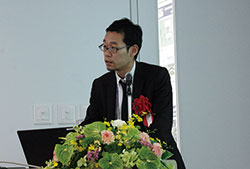 |
 Hideaki Yamaga, Nihon Suiko Sekkei Co., Ltd. Hideaki Yamaga, Nihon Suiko Sekkei Co., Ltd.
Tokyo Branch Sewer First Department Planning Division Chief Examiner |
Subsequently, Mr. Mudaliar and Mr. Kuch of XP Solutions Inc., the developer
of xpswmm, gave a special lecture on "The latest case studies of flood
simulation model xpswmm 2014". The lecture focused on analysis case
studies targeting heavy floods that occurred in various places around the
world such as Southeast Asia and North America. During the Q&A session,
there was an intense discussion with the participants on specific methods
of modeling such those used to define building height and geomorphic surface
elevation.
 |
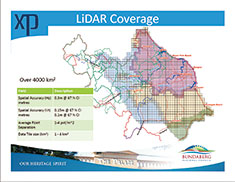 |
 Mr. Sudesh Mudaliar, XP Solutions Inc. Vice President - Asia Pacific Mr. Sudesh Mudaliar, XP Solutions Inc. Vice President - Asia Pacific |
In this Design Festival, this year, 3 new books are introduced and published
from FORUM8 Publishing, and Mr. Masaru Morita, who is the author of "Flood
risk analysis of urban areas -from disaster risk reduction to risk management-"
which is one of the new books, has done a lecture with the theme of "Analysis
of flood risk in urban area : The current situation and tasks". Mr.
Morita has introduced the history of runoff analysis models and the ways
of thinking of risk management, which it cannot be said that it has spread
enough in Japan in comparison to the West. As an application of flood risk
assessment, explanations has also been done for the items such as the decision
of the highest standard of flood control and rain water draining plan,
predictions of flood risk increase due to climate change, and risk reduction
effect by rain water draining project. Also, future tasks and prospects
were mentioned, such as evaluations of infrastructure damages taking in
account the uncertainties of flood risks.
 |
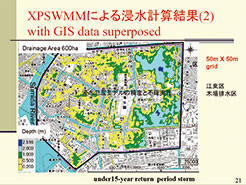 |
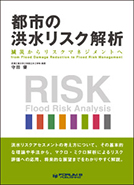 |
 Professor of Civil Engineering, Professor of Civil Engineering,
College of Engineering, Shibaura Institute of Technology, Masaru Morita |
In this session, a panel discussion composed by 5 panelists, the lecturer
Mr. Yamaga, Mr. Sudes and Mr. Kuch, Mr. Morita, and the developer of FORUM8,
has been held at the same time. Having "what are the things expected
in analysis software / future image of analysis software" as the theme,
an intense discussion has been done, which also served as an exchange of
opinions and information between the users and the developer.
Mr. Morita, from the position of his research, has mentioned about the utilization prospects of xpswmm in the field of risk management, and has emphasized the importance of how to perceive hazards and the maintenance of data sets. He has also stated about the future tasks, such as presenting results calculated in real time based on real time information of a laser. Also, Mr. Yamakaga has introduced the method of damage amount calculation which he has started initiating in his consulting services. The realization of the effective use of databases and improvement of throughput by the cloud has been proposed to be necessary.
In contrast, Mr. Sudesh and Mr. Kuch of the XP Solutions Inc., as the future
development of xpswmm, similarly claimed the necessity of maintaining databases,
stating the idea that it integrates various solutions and becomes available
for large-scale data.
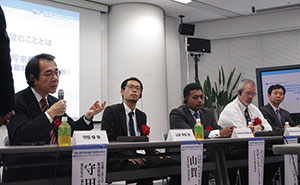 |
 During the panel discussion During the panel discussion |
In the presentation by the FORUM8 developer, which was also carried in
conjunction, the overview and the latest functions and solutions of all
the 26 products of the hydraulic engineering series has been introduced,
such as sewerage and waterworks, river structures, runoff analysis and
flood analysis. A demonstration mixed with actual operation was done about
the cooperation of xpswmm and UC-win/Road, and the cooperation of the design
of manholes and 3D reinforcement arrangement CAD.
 |
 Isamu Okaki, Isamu Okaki,
manager of FORUM8 UC-1 development group 1 |

Proposals on a highly sophisticated use of point cloud data, application
of VR technology in education, BIM/CIM linkage were the highlights
The opening remarks was given by Mr. Kobayashi (Prism lab. Of Arizona State
University) before starting the 7th annual international VR symposium and
research talk since the summer workshop in Hawaii (July, 2014) given by
World 16 members.
He introduced the past achievements of World 16, this symposium's progress and the achievements of Hawaii Workshop. After that, the member's lectures started from "Drone&VR : Research for 3D modeling via UAV(Unmanned Aerial Vehicle)" given by Matthew Swarts.
 |
 Mr. Yoshihiro Kobayashi Prism lab. Mr. Yoshihiro Kobayashi Prism lab.
Of Arizona State University,
representative of FORUM8 AZ |
Mr. Swarts's research is to use photogrammetry and point cloud data via
UAV (Unmanned Aerial Vehicles) in VR environment. Conduct the camera match
and rendering to the aerial sequence photographs and movies of the development
site along the flight path set by GPS and the addition of mesh data and
textures can also be done. On top of that, zoom of high-resolution data
and even the detail tracking of pedestrians' movement are used for analysis
and prediction. Eventually in his lecture, the map data was read into UC-win/Road,
roads were created and trees and buildings etc. were reproduced from point
clouds.
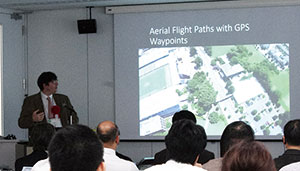 |
 Mr. Matthew Swarts, Mr. Matthew Swarts,
Georgia Institute of Technology |
The unique lecture entitled "Laser scanner for research about the
cave of bats" was given by Mr. Thomas Tucker, Virginia Polytechnic
Institute and State University. As for the projects reproducing the internal
shape of the cave in Shandong, China and analysis about a bat's movement
living in the cave , which was in the news at the workshop in Hawaii, the
process to measure the skeleton of a bat via micro CT scan to create its
3D model and reproduce the sophisticated flight routes and behavior s of
it via motion-capture was introduced. In addition, he introduced the new
case study to make the location in France where the First World War was
waged as 3D model, link with AR or read it into UC-win/Road and then use
it for education.
 |
 Mr. Thomas Tucker, Mr. Thomas Tucker,
Virginia Polytechnic Institute and State University |
Associate Prof. Kostas Terzidis, Harvard University gave his lecture entitled
"Organic parking : The parking's booking system on cloud" which
draws attention as a new business model. This is a system, 'Organic parking'
developed by him, which makes it possible to trade the usable time of a
parking space interpersonally seeking a solution to reduce a lot of stress
commonly caused in the world cities that the parking space cannot be smoothly
found when it is necessary. Practically, he explained about the mechanism
to realize the trading system via cloud by showing the demonstration movie
in which how to operate the system is recorded and an animated catchy promotion
movie.
 |
 Mr. Kostas Terzidis, Mr. Kostas Terzidis,
Associate Professor of Harvard University |
In the lecture entitled "Real-time system for urban planning via VR-Cloud®"
given by Associated Prof. Tomohiro Fukuda, he proposed to synchronously-share
3D spaces via VR-Cloud® and then to have a design consideration and conference
as the future meeting style which will have more advanced internationalization
and informatization.
The consideration of landscape and design in Shimonoseki, Yamaguchi was introduced as a case example. In his demonstration, the whole process to share the data via VR-Cloud® and examine by connecting voice and video with the laboratory in Osaka University via the meeting system was reproduced. He also described about from the current standalone use to the future networked vision.
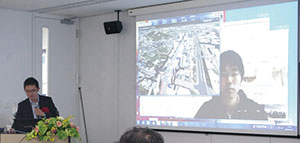 |
 Mr. Tomohiro Fukuda, Mr. Tomohiro Fukuda,
Associate Professor of Osaka University |
The lecture entitled "Case examples of the linkage of interactive
devices and VR" was given by Associate Prof. Taro Narahara, New Jersey
Institute of Technology (NJIT) and his wide variety of efforts was introduced
including the use of robotics for business and education in architecture
field via the devices including laser cutters and sensors etc. As for crowd
simulation mounted as one of the functions in UC-win/Road, the method to
consider the efficiency in dynamic state and human behaviors for architectural
design and then design the things not only from the geometric point of
view but also correlativity was explained. Moreover, as the recent field
of concern, taking 'Haptics' which gives the tactile feedback to the virtual
objects as an example, he also illustrated that he was searching for the
application of 'Haptics' to the game for rehabilitation etc. with a hospital
research team in New Jersey Institute of Technology.
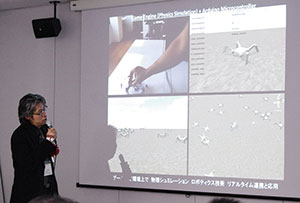 |
 Mr. Taro Narahara, Mr. Taro Narahara,
Associate Professor of New Jersey Institute of Technology (NJIT) |
Prof. Paolo Fiamma of University of Pisa introduced about BIM application
using the models of UC-win/Road and IFC etc. for a redevelopment project
in an old city area in his lecture entitled "Research for use of VR
in Pisa, Italy". He also gave an explanation about the merit to be
able to contribute to the reduction of time and cost by using BIM models
of the addition of attributes including materials, cost and time etc. and
the case study to efficiently simulate what kinds of event happen in the
town by importing the models of the new buildings and facilities into VR
spaces as well as simulating its influence to the crowd flow and traffic.
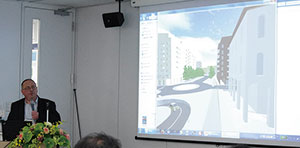 |
 Mr. Paolo Fiamma, Professor of University of Pisa Mr. Paolo Fiamma, Professor of University of Pisa |
He also gave an explanation about the merit to be able to contribute to
the reduction of time and cost by using BIM models of the addition of attributes
including materials, cost and time etc. and the case study to efficiently
simulate what kinds of event happen in the town by importing the models
of the new buildings and facilities into VR spaces as well as simulating
its influence to the crowd flow and traffic. One of the most noticeable
topics in the symposium this year was the proposal for educational use
of VR. Associate Prof. Amar Bennadji's lecture entitled "Online education
research via VR" was one of them and his research to search for the
best use of UC-win/Road as an education tool for students was introduced
from his point of view who is also a manager of online education course
being planned for the future in his university. "The redevelopment
of Aberdeen's Union Street" is adopted as the actual case study after
conducting the trials for students as a part of the course on visualizing
buildings, architectural environment and planning. He evaluated UC-win/Road's
possibility as an education tool and collaboration tool and also its operability
of ideas by designing and planning via conference or presentation without
face-to-face talking with local municipal employees via VR.
 |
 Mr. Amar Bennadji, Mr. Amar Bennadji,
Associate professor of Robert Gordon University |
Finally, Associate Prof. Wael Abdelhameed gave his presentation entitled "VR application for 4D construction project". He introduced his study result about VR use for construction project management. The method to use 3D models for scheduling of a project management was illustrated as well as showing an animation visualizing the building construction and construction process and expressing the construction process from basic to floor, wall and ceiling.
It was shown that the enough logical construction and its process would lead to the good vision for BIM use in the future. Moreover the use of VR for evaluating students' creativities working on the urban design project as a new approach was introduced and VR availability as an education tool was impressed here as well.
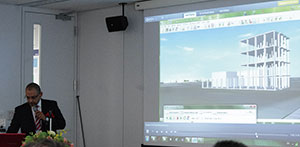 |
 Mr. Wael Abdelhameed, Mr. Wael Abdelhameed,
Associate professor of University of
Bahrain |
FORUM8 Design Festival 2015-3Days
Venue : FORUM8 Tokyo Head Office / Shinagawa Intercity Hall
| Eve Nov 17, 2015 (Thu) |
FORUM8 Design Festival Eve |
| Day1 Nov 18, 2015 (Wed) |
15th UC-win/Road Conference |
| Day2 Nov 19, 2015 (Thu) |
14th Award Ceremony for 3D VR Simulation Contest on Cloud
15th UC-win/Road Congress
9th Design Conference
5th Award Ceremony for VDWC / CPWC |
| Day3 Nov 20, 2015 (Fri) |
9th Design Conference
2nd Award Ceremony for National Regilience Award
8th International VR Symposium |
|
|




















































































